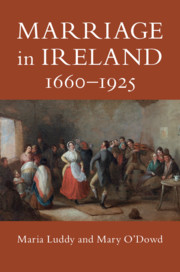Book contents
- Marriage in Ireland, 1660–1925
- Marriage in Ireland, 1660–1925
- Copyright page
- Dedication
- Contents
- Figures
- Illustrations
- Tables
- Acknowledgements
- Abbreviations
- Introduction
- Part I What Is a Marriage?
- Part II Ways to Marriage
- 3 Meeting and Matching with a Partner
- 4 Courtship Behaviour
- 5 Breach of Promise
- 6 Abductions
- Part III Happy Ever After?
- Part IV The Unmaking of Marriage
- Conclusion
- Select Bibliography
- Index
5 - Breach of Promise
from Part II - Ways to Marriage
Published online by Cambridge University Press: 04 June 2020
- Marriage in Ireland, 1660–1925
- Marriage in Ireland, 1660–1925
- Copyright page
- Dedication
- Contents
- Figures
- Illustrations
- Tables
- Acknowledgements
- Abbreviations
- Introduction
- Part I What Is a Marriage?
- Part II Ways to Marriage
- 3 Meeting and Matching with a Partner
- 4 Courtship Behaviour
- 5 Breach of Promise
- 6 Abductions
- Part III Happy Ever After?
- Part IV The Unmaking of Marriage
- Conclusion
- Select Bibliography
- Index
Summary
A breach of promise to marry is a fundamental break of a promise, by either a man or woman, to carry through a marriage.The legal action had its origins in the canon law definition of marriage as a promise between a man and a woman.Ecclesiastical courts had an obligation to ensure that when a promise of marriage was made that both parties recognized that they had entered into a clandestine but valid marriage.In Ireland, civil suits for breach of promise seem to have begun in the middle years of the eighteenth century.It was primarily through the courts that breach of promise to marry cases came to the attention of the public, providing lawyers with lucrative incomes and newspapers with titillating stories for their reading audience. The actual court cases themselves were a form of public entertainment and the court room the arena of performance for witnesses, barristers, judges. Exploring the history of breach of promise cases in Ireland reveals the significance of monetary considerations in marriage negotiations, and the value that was placed on women’s, and men’s, reputations. Such cases also throw light on class, the appropriateness of cross-class relationships and the significance of social status among plaintiffs and defendants.
Keywords
- Type
- Chapter
- Information
- Marriage in Ireland, 1660–1925 , pp. 158 - 180Publisher: Cambridge University PressPrint publication year: 2020

